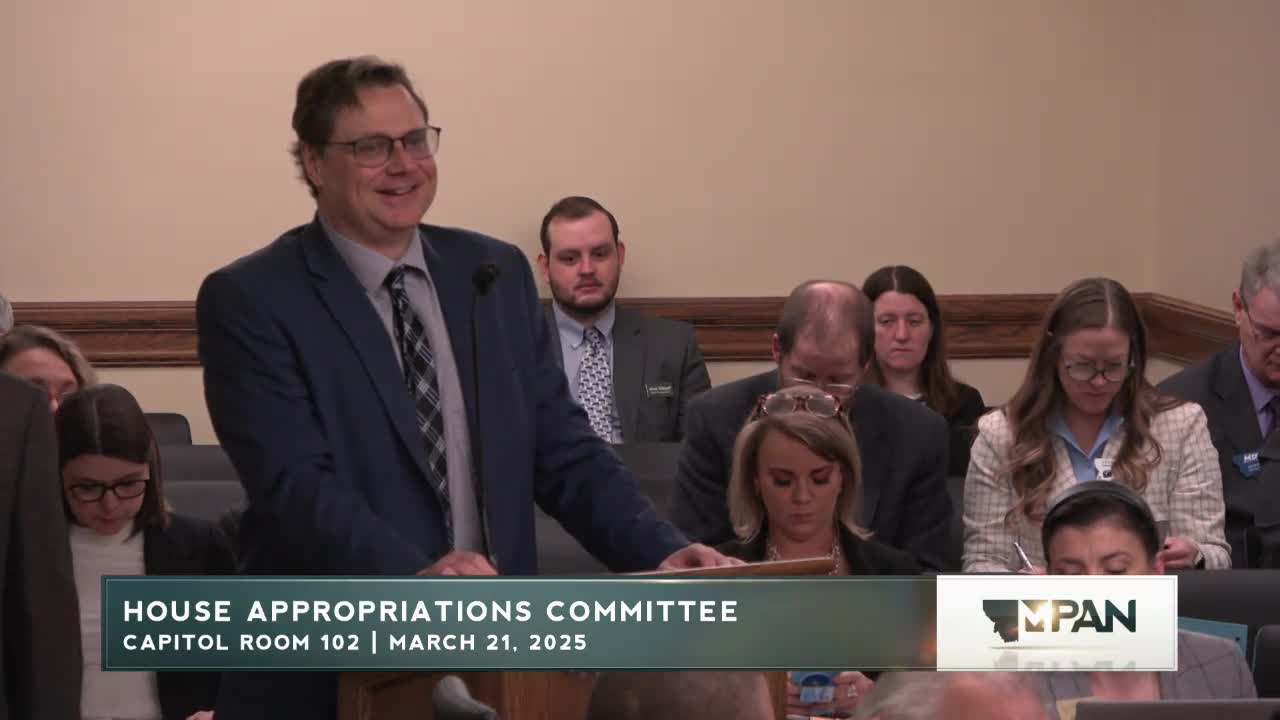State IT chief explains SITSD billing, onshore cloud costs tied to DPHHS budget increases
March 21, 2025 | 2025 Legislature MT, Montana
This article was created by AI summarizing key points discussed. AI makes mistakes, so for full details and context, please refer to the video of the full meeting. Please report any errors so we can fix them. Report an error »

Kevin Gilbertson, chief information officer for the state, told the House Appropriations Subcommittee that State Information Technology Services Division (SITSD) operates like a proprietary service bureau that bills agencies for enterprise and usage-based services.
Gilbertson said the SITSD budget consists of required enterprise and cybersecurity rates plus usage-based charges for custom applications, hosting, and expert time. "We bill them for products and services," he said. He described enterprise charges covering identity and access (Active Directory), Microsoft enterprise licensing, enterprise website tools and a mandated cybersecurity rate that includes identity management and logging (Splunk) to support incident investigations.
The CIO presented a DPHHS-specific spreadsheet showing pass‑through software costs, services allocations that include support hours, hosting and live storage increases, and under‑allocation corrections. Gilbertson said some increases reflect growth in agency usage (for example, more live storage and VDI usage) and other increases reflect higher vendor rates after agencies required onshore hosting and stricter security certifications.
Gilbertson explained that federal and state government requirements limit use of overseas support and foreign data centers. "When we said that [offshore support] was unacceptable, they said, 'okay, here's the price to go along with it,'" he said, referring to a vendor that raised charges to provide onshore government‑cloud services. He also cited FedRAMP‑style certification and other security work as cost drivers beyond raw storage prices.
Representative Falk asked whether onshore cloud storage is substantially more expensive and why. Gilbertson responded that it is not simply onshore vs. offshore; certification and security requirements (FedRAMP and similar reviews) increase costs because they require more intensive controls and documentation.
Committee members asked whether the DPHHS spreadsheet satisfied their information request; the chair noted it was provided before final EA decisions. Representative Falk requested follow‑up meetings with SITSD, DPHHS and the Legislative Fiscal Division to reconcile section A actions with what DPHHS is being billed.
The CIO said SITSD calculates enterprise allocations proportionally by agency size (for example, AD account counts), while usage‑based charges are invoiced directly for hosted applications and development. He offered to provide similar line‑by‑line breakdowns for other agencies but cautioned the process takes time.
The spreadsheet and testimony were provided as the subcommittee prepared final agency appropriation decisions for House Bill 2.
Gilbertson said the SITSD budget consists of required enterprise and cybersecurity rates plus usage-based charges for custom applications, hosting, and expert time. "We bill them for products and services," he said. He described enterprise charges covering identity and access (Active Directory), Microsoft enterprise licensing, enterprise website tools and a mandated cybersecurity rate that includes identity management and logging (Splunk) to support incident investigations.
The CIO presented a DPHHS-specific spreadsheet showing pass‑through software costs, services allocations that include support hours, hosting and live storage increases, and under‑allocation corrections. Gilbertson said some increases reflect growth in agency usage (for example, more live storage and VDI usage) and other increases reflect higher vendor rates after agencies required onshore hosting and stricter security certifications.
Gilbertson explained that federal and state government requirements limit use of overseas support and foreign data centers. "When we said that [offshore support] was unacceptable, they said, 'okay, here's the price to go along with it,'" he said, referring to a vendor that raised charges to provide onshore government‑cloud services. He also cited FedRAMP‑style certification and other security work as cost drivers beyond raw storage prices.
Representative Falk asked whether onshore cloud storage is substantially more expensive and why. Gilbertson responded that it is not simply onshore vs. offshore; certification and security requirements (FedRAMP and similar reviews) increase costs because they require more intensive controls and documentation.
Committee members asked whether the DPHHS spreadsheet satisfied their information request; the chair noted it was provided before final EA decisions. Representative Falk requested follow‑up meetings with SITSD, DPHHS and the Legislative Fiscal Division to reconcile section A actions with what DPHHS is being billed.
The CIO said SITSD calculates enterprise allocations proportionally by agency size (for example, AD account counts), while usage‑based charges are invoiced directly for hosted applications and development. He offered to provide similar line‑by‑line breakdowns for other agencies but cautioned the process takes time.
The spreadsheet and testimony were provided as the subcommittee prepared final agency appropriation decisions for House Bill 2.
View full meeting
This article is based on a recent meeting—watch the full video and explore the complete transcript for deeper insights into the discussion.
View full meeting
